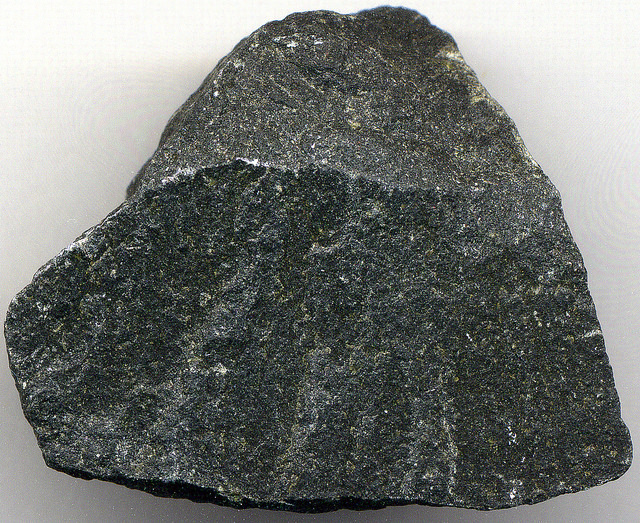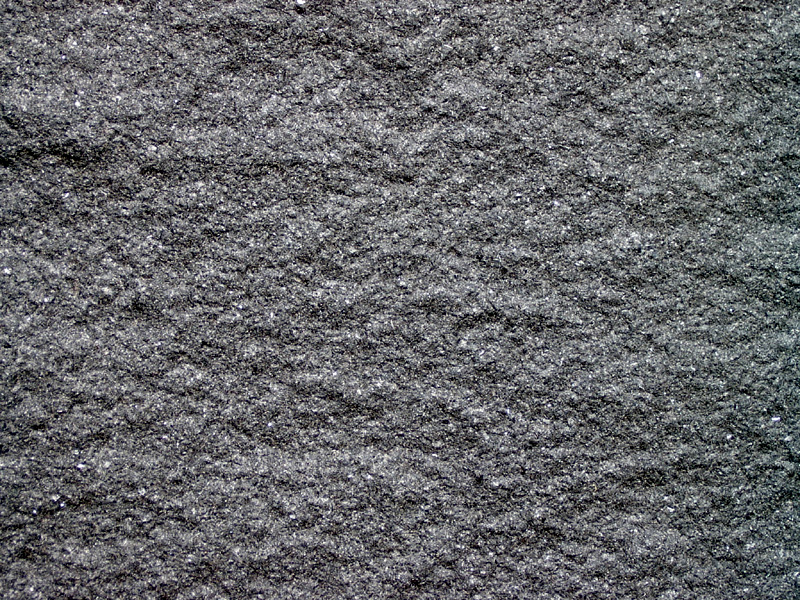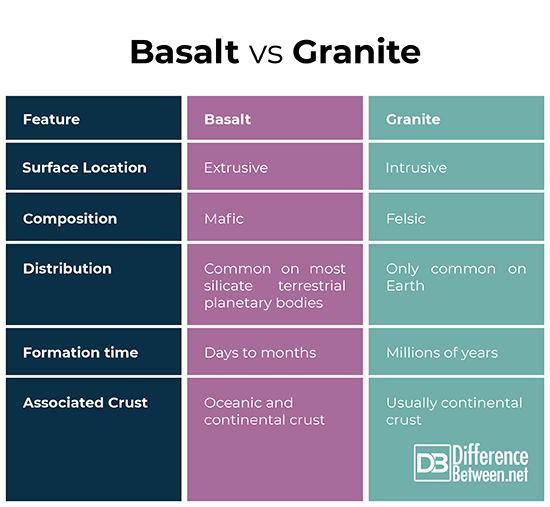Difference Between Basalt and Granite
What is Basalt?
Basalt is an igneous, mafic, and volcanic rock which is produced by lava flows in many different volcano types. It contains mainly volcanic glass, pyroxene and plagioclase feldspar and is fine-grained. Basalt is one of the most common types of rock on Earth as well as other planetary bodies in the Solar System.
Composition of Basalt
Since basalt is mafic, it contains minerals with significant iron and magnesium. The minerals making up basalt include pyroxene, plagioclase feldspar, amphibole, and some olivine. Volcanic glasses are also present. Some of the minerals composing basalt, such as olivine, are very sensitive to chemical weathering at Earth’s surface because of the presence of water.
Formation of Basalt
Basalt forms at the surface where it will harden from lava. Places where basalt is abundant include mid oceanic ridges, hot spots, and rift basins. Because it forms at the surface, basalt will cool relatively quickly within a few days to a few months and, as a result, the minerals grains in basalt are fine grained and difficult to see with the unaided eye.

Mid-oceanic ridges
The mid oceanic ridges are a type of boundary between two tectonic plates composed of oceanic crust. It is at the mid oceanic ridges where new oceanic crust is formed. The upper 1-2 km of the oceanic crust is basalt. The basalt that forms at the mid oceanic ridges has a specific composition that makes it distinctive, as a result, basalt deposits that form at the mid oceanic ridges are called MORB (Mid-Oceanic-Ridge-Basalt) deposits or MORBs.
Hotspots
Hotspots are regions near the base of the crust where a plume of hot mantle material causes volcanic activity at the surface. When hotspots occur beneath oceanic crust, the resulting molten rock will often produce basaltic lavas. Examples of basalt deposits that form at hotspots include the basalt bedrock of the Hawaiian Islands. The Martian volcanoes of Tharsis, Olympus Mons, Ascreaus Mons, and Arsia Mons, are likely examples of hotspot volcanism on a much larger scale than terrestrial cases.
Rift basins
Basalt is also commonly formed at continental rifts. Mantle plumes can form beneath the continental crust causing extension of the lithosphere and the production of significant melt in the crust. If the melt extrudes onto the surface, this can lead to extensive basalt flows that form what are called flood basalts where hundreds of square kilometers of basaltic lava can be produced.

What is Granite?
Granite is an intrusive igneous rock with a felsic composition. Granite makes up the cores of continents and much of the bulk of major mountain ranges around the world. Furthermore, many of the continental rock formations are ultimately derived from granite that either was destroyed by weathering and erosion or metamorphosed. Granite is also one of the most recognizable rocks to most people.
Composition of Granite
Granite is classified as a felsic rock, meaning that it has significant amounts of feldspar and quartz. The primary minerals making up granite include quartz, feldspars, micas, and sometimes pyroxene, but mostly quartz and feldspar. Because granite often has excess potassium from alkali feldspars, granite is slightly radioactive because radioactive potassium (40K) is relatively common. Not all rocks that resemble granite are true granites. These rocks that resemble granite physically, chemically, and mineralogically but that are not in fact granite are referred to as granitoids.
Formation of Granite
Granite is considered a plutonic rock since it forms deep beneath the surface. Plutonic rocks are contrasted with volcanic rocks which form at the surface. Granite tends to form at continental subduction zones where oceanic crust is subducting beneath continental crust. It will also form at continental collisions zones.
During the process of plate subduction or continental collision, large chambers of magma will form within the crust which will harden into masses of rock called plutons. As tectonic plates collide, they are compressed, and the plutons are uplifted and exhumed at the surface. Over time, the surrounding rock will erode away leaving the plutons as enormous masses of exposed granite. The granite peaks of many of the world’s major mountain ranges are examples of plutons around which surface rock has eroded to expose these ancient subterranean stone giants.
Similarities between Basalt and Granite
Basalt and granite are both silicate rocks which contain common minerals such as feldspar and pyroxene. They also are both very common rocks on Earth. Furthermore, they are both igneous, meaning that they form from direct crystallization of molten rock.
Differences between basalt and granite
Although there are some similarities between basalt and granite, there are also significant differences between these two rock types.
- Basalt is volcanic, or extrusive, forming at the surface, while granite is plutonic, or intrusive, forming beneath the surface.
- Basalt is mafic while granite is felsic
- Basalt is common on both Earth and other Solar System bodies such as the Moon and Mars while granite is only common on Earth and rare elsewhere in the Solar System
- Basalt can form in a few days to months, whereas granite plutons can take millions of years to cool and harden.
- Basalt is more common in oceanic crust while granite is more common in continental crust.
Basalt Vs. Granite

Summary of Basalt Vs. Granite
Basalt is an igneous, volcanic rock that forms commonly in oceanic crust and parts of continental crust. It forms from lava flows which extrude onto the surface and cool. Its principle minerals include pyroxene, feldspar, and olivine. It is common both on Earth and other planetary bodies. Granite is an igneous plutonic rock which is very common in continental crust. It forms from subterranean magma chambers that cool and harden beneath the surface and then become exhumed and exposed at the surface. Basalt and granite are similar in the they are both igneous, silicate rocks and common on Earth. They also have numerous differences. Basalt is extrusive, mafic, and common throughout the Solar System whereas granite is intrusive, felsic, and common only on Earth.
- Difference Between Environmental Performance Index and Development - November 24, 2023
- Difference Between Environmental Intervention and Development - November 8, 2023
- Difference Between Eco Efficiency and Eco Effectiveness - September 18, 2023
Search DifferenceBetween.net :
 Email This Post
: If you like this article or our site. Please spread the word. Share it with your friends/family.
Email This Post
: If you like this article or our site. Please spread the word. Share it with your friends/family.
3 Comments
Leave a Response
References :
[0]Image credit: https://upload.wikimedia.org/wikipedia/commons/c/cf/Black-granite.jpg
[1]Image credit: https://www.flickr.com/photos/jsjgeology/16540710327
[2]Eggleton, Richard A., Chris Foudoulis, and Dane Varkevisser. "Weathering of basalt: changes in rock chemistry and mineralogy." Clays and Clay Minerals 35.3 (1987): 161-169.
[3]Condie, Kent C. Earth as an evolving planetary system. Academic Press, 2015. le Roex A.P. (1998)
[4]Mid-ocean ridge basalt (MORB). In: Geochemistry. Encyclopedia of Earth Science. Springer, Dordrecht
[5]Carr, Michael H. "The volcanoes of Mars." Scientific American234.1 (1976): 32-43.
[6]Day, James MD. "Hotspot volcanism and highly siderophile elements." Chemical Geology 341 (2013): 50-74.
[7]White, Robert, and Dan McKenzie. "Magmatism at rift zones: the generation of volcanic continental margins and flood basalts." Journal of Geophysical Research: Solid Earth 94.B6 (1989): 7685-7729.
[8]Myers, J. S. "Geology of granite." Journal of the Royal Society of Western Australia 80 (1997): 87


Nice
Sooo… which one’s harder? Which one’s more porous? What’s the actual difference?
Thanks Caleb. A very clear explanation. One question, what is the specific source of the ‘extra’ silica in granite?